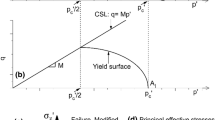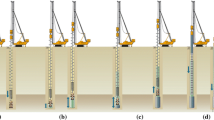Abstract
The penetration of rigid objects such as piles and penetrometers into soils creates a zone of soil disturbance around them. The extent of this disturbed zone influences the resistance of the moving rigid body. This paper presents a theoretical framework to analyze the resistance in the disturbed zone created by a shaft penetrating a clay soil. The soil is modeled as a viscous material after it reaches failure [critical state (CS)]. The results of this analysis show that the viscous drag stress component on the shaft surface is influenced by the size of disturbed zone that has reached CS around the shaft, the shear viscosity of the soil and the velocity profile (or strain rate) in the CS zone around the shaft. The size of CS zone, the velocity profile and the viscosity of soil are interdependent. Large variation in viscous drag occurs when the size of the CS soil zone is less than four times the shaft’s radius. Limiting drag occurs when the size of the CS soil zone exceeds six times the shaft’s radius. The theoretical velocity distribution of the movement of soil in the CS zone shows that the soil is dragged along with shaft in the near field (close to the shaft surface) and moves upwards in the far field.






Similar content being viewed by others
References
API (1984) API recommended practice for planning, designing and constructing fixed offshore platforms. American Petroleum Institute, Washington
Baligh MM (1985) Strain path method. J Geotech Eng Div ASCE 111(9):1108–1136
Berry AJ (1982) The dynamic penetration of clays. In: De Ruiter J (ed) Proceedings of the 1st international symposium on penetration testing, ISOPT1, Orlando 1988. A. A. Balkema, Rotterdam, pp 673–680
Budhu M (1985) The effect of clay content on liquid limit from fall cone and British cup device. Geotech Test J ASTM 8(2):91–95
Cooke RW, Price G (1973) Strains and displacements around friction piles. In: Proceedings of the 8th international conference on SMFE, vol 2, issue 1, Moscow, pp 53–60
Coussot P, Nguyen QD, Huynh HT, Bonn D (2002) Avalanche behavior in yield stress fluids. Phy Rev Lett 88(17), 175501(4)
Cummins AE, Kerkhoff GO, Peck RB (1948) Effect of driving piles into soft clay. Trans ASCE. Paper no. 2400; 115:275–285
Edgers L, Karlsrud K (1985) Viscous analysis of submarine flows. In: Proceedings of the 4th international conference on the behaviour of offshore structures, developments in marine technology, vol 2, Delft, pp 773–784
Esrig MI, Kirby RC, Bea RG, Murphy BS (1977) Initial development of a general effective stress method for prediction of axial capacity for driven piles in clay. In: Proceedings of the 9th annual offshore technology conference, OTC paper 2943, Houston, pp 495–506
Flaate K (1972) Effects of pile driving in clays. Can Geotech J 9:81–88
Hansbo S (1957) A new approach to the determination of the shear strength of clay by the fall-cone test. In: Proceedings of the royal swedish geotechnical institute, no. 14, Stockholm, pp 1–47
Happel J, Brenner H (1965) Low Reynolds number hydrodynamics with special applications to particulate media, Prentice-Hall, Englewood Cliffs
Houlsby GT (1982) Theoretical analysis of the fall cone test. Geotechnique 32(2):111–118
Kirby RC, Wroth CP (1977) Application of critical state soil mechanics to the prediction of axial capacity for driven piles in clay. In: Proceedings of the 9th annual offshore technology conference, OTC paper 2942, Houston, pp 483–494
Koumoto T, Houlsby GT (2001) Theory and practice of the fall cone test. Geotechnique 51(8):701–712
Lamb H (1965) Hydrodynamics, 6th edn. Cambridge University Press, England
Locat J, Demers D (1988) Viscosity, yield stress, remolded strength, and liquidity index relationships for sensitive clays. Can Geotech J 25(4):799–806
Marsland A, Quarterman RST (1982) Factors affecting the measurements and interpretation of quasi static penetration tests in clays. In: Verruijt A, Beringen FL, De Leeuw EH (eds) Proceedings of the 2nd European symposium on penetration testing, ESOPT II, vol 2, Amsterdam 1982. A. A. Balkema, Rotterdam, pp 697–702
Nguyen QD, Boger DV (1992) Measuring the flow properties of yield stress fluids. Annu Rev Fluid Mech 24:47–88
Randolph MF, Carter JP, Wroth CP (1979) Driven piles in clay—the effects of installation and subsequent consolidation. Geotechnique 29(4):361–393
Sagaseta C, Whittle AJ (2001) Prediction of ground movements due to pile driving in clay. J Geotech Geoenv Eng ASCE 127(1):55–66
Schofield A, Wroth CP (1968) Critical state soil mechanics. McGraw-Hill, London
Suhayda JN, Prior DB (1978) Explanation of submarine landslide morphology by stability analysis and rheologic models. In: Proceedings of the 10th annual offshore technology conference, OTC paper 3171, Houston, pp 1075–1082
Turnage GW (1973) Influence of viscous type and inertial forces on the penetration resistance of saturated fine grained soils. J Terramech 10(2):63–76
Vyalov SS (1986) Rhelogical fundamentals of soil mechanics. Developments in Geotechnical Engineering, vol 36. Elsevier, Amsterdam
Wood DM (1985) Some fall-cone tests. Geotechnique 35(1):64–68
Zeevart L (1948) Discussion on effect of driving piles into soft clay. Tran ASCE 115:286–292
Author information
Authors and Affiliations
Corresponding author
Rights and permissions
About this article
Cite this article
Mahajan, S.P., Budhu, M. Viscous effects on penetrating shafts in clays. Acta Geotech. 1, 157–165 (2006). https://doi.org/10.1007/s11440-006-0014-8
Received:
Revised:
Accepted:
Published:
Issue Date:
DOI: https://doi.org/10.1007/s11440-006-0014-8




